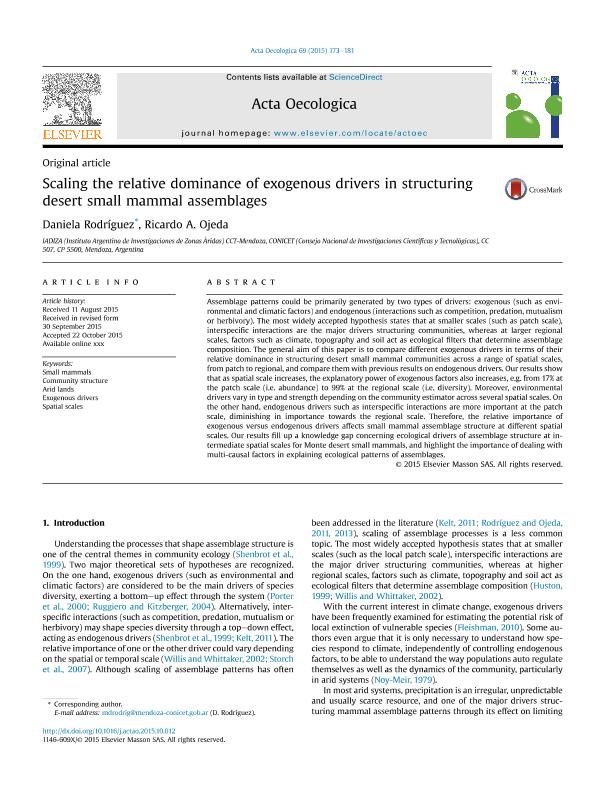Mostrar el registro sencillo del ítem
dc.contributor.author
Rodriguez, Maria Daniela

dc.contributor.author
Ojeda, Ricardo Alberto

dc.date.available
2018-05-18T18:05:32Z
dc.date.issued
2015-11
dc.identifier.citation
Rodriguez, Maria Daniela; Ojeda, Ricardo Alberto; Scaling the relative dominance of exogenous drivers in structuring desert small mammal assemblages; Gauthier-Villars/Editions Elsevier; Acta Oecologica; 69; 11-2015; 173-181
dc.identifier.issn
1146-609X
dc.identifier.uri
http://hdl.handle.net/11336/45599
dc.description.abstract
Assemblage patterns could be primarily generated by two types of drivers: exogenous (such as environmental and climatic factors) and endogenous (interactions such as competition, predation, mutualism or herbivory). The most widely accepted hypothesis states that at smaller scales (such as patch scale), interspecific interactions are the major drivers structuring communities, whereas at larger regional scales, factors such as climate, topography and soil act as ecological filters that determine assemblage composition. The general aim of this paper is to compare different exogenous drivers in terms of their relative dominance in structuring desert small mammal communities across a range of spatial scales, from patch to regional, and compare them with previous results on endogenous drivers. Our results show that as spatial scale increases, the explanatory power of exogenous factors also increases, e.g. from 17% at the patch scale (i.e. abundance) to 99% at the regional scale (i.e. diversity). Moreover, environmental drivers vary in type and strength depending on the community estimator across several spatial scales. On the other hand, endogenous drivers such as interspecific interactions are more important at the patch scale, diminishing in importance towards the regional scale. Therefore, the relative importance of exogenous versus endogenous drivers affects small mammal assemblage structure at different spatial scales. Our results fill up a knowledge gap concerning ecological drivers of assemblage structure at intermediate spatial scales for Monte desert small mammals, and highlight the importance of dealing with multi-causal factors in explaining ecological patterns of assemblages.
dc.format
application/pdf
dc.language.iso
eng
dc.publisher
Gauthier-Villars/Editions Elsevier

dc.rights
info:eu-repo/semantics/openAccess
dc.rights.uri
https://creativecommons.org/licenses/by-nc-sa/2.5/ar/
dc.subject
ARID LANDS
dc.subject
COMMUNITY STRUCTURE
dc.subject
EXOGENOUS DRIVERS
dc.subject
SMALL MAMMALS
dc.subject
SPATIAL SCALES
dc.subject.classification
Otras Ciencias Biológicas

dc.subject.classification
Ciencias Biológicas

dc.subject.classification
CIENCIAS NATURALES Y EXACTAS

dc.title
Scaling the relative dominance of exogenous drivers in structuring desert small mammal assemblages
dc.type
info:eu-repo/semantics/article
dc.type
info:ar-repo/semantics/artículo
dc.type
info:eu-repo/semantics/publishedVersion
dc.date.updated
2018-04-18T17:51:03Z
dc.journal.volume
69
dc.journal.pagination
173-181
dc.journal.pais
Francia

dc.journal.ciudad
Paris
dc.description.fil
Fil: Rodriguez, Maria Daniela. Consejo Nacional de Investigaciones Científicas y Técnicas. Centro Científico Tecnológico Conicet - Mendoza. Instituto Argentino de Investigaciones de las Zonas Áridas. Provincia de Mendoza. Instituto Argentino de Investigaciones de las Zonas Áridas. Universidad Nacional de Cuyo. Instituto Argentino de Investigaciones de las Zonas Áridas; Argentina
dc.description.fil
Fil: Ojeda, Ricardo Alberto. Consejo Nacional de Investigaciones Científicas y Técnicas. Centro Científico Tecnológico Conicet - Mendoza. Instituto Argentino de Investigaciones de las Zonas Áridas. Provincia de Mendoza. Instituto Argentino de Investigaciones de las Zonas Áridas. Universidad Nacional de Cuyo. Instituto Argentino de Investigaciones de las Zonas Áridas; Argentina
dc.journal.title
Acta Oecologica

dc.relation.alternativeid
info:eu-repo/semantics/altIdentifier/doi/http://dx.doi.org/10.1016/j.actao.2015.10.012
dc.relation.alternativeid
info:eu-repo/semantics/altIdentifier/url/https://www.sciencedirect.com/science/article/pii/S1146609X15300369
Archivos asociados
